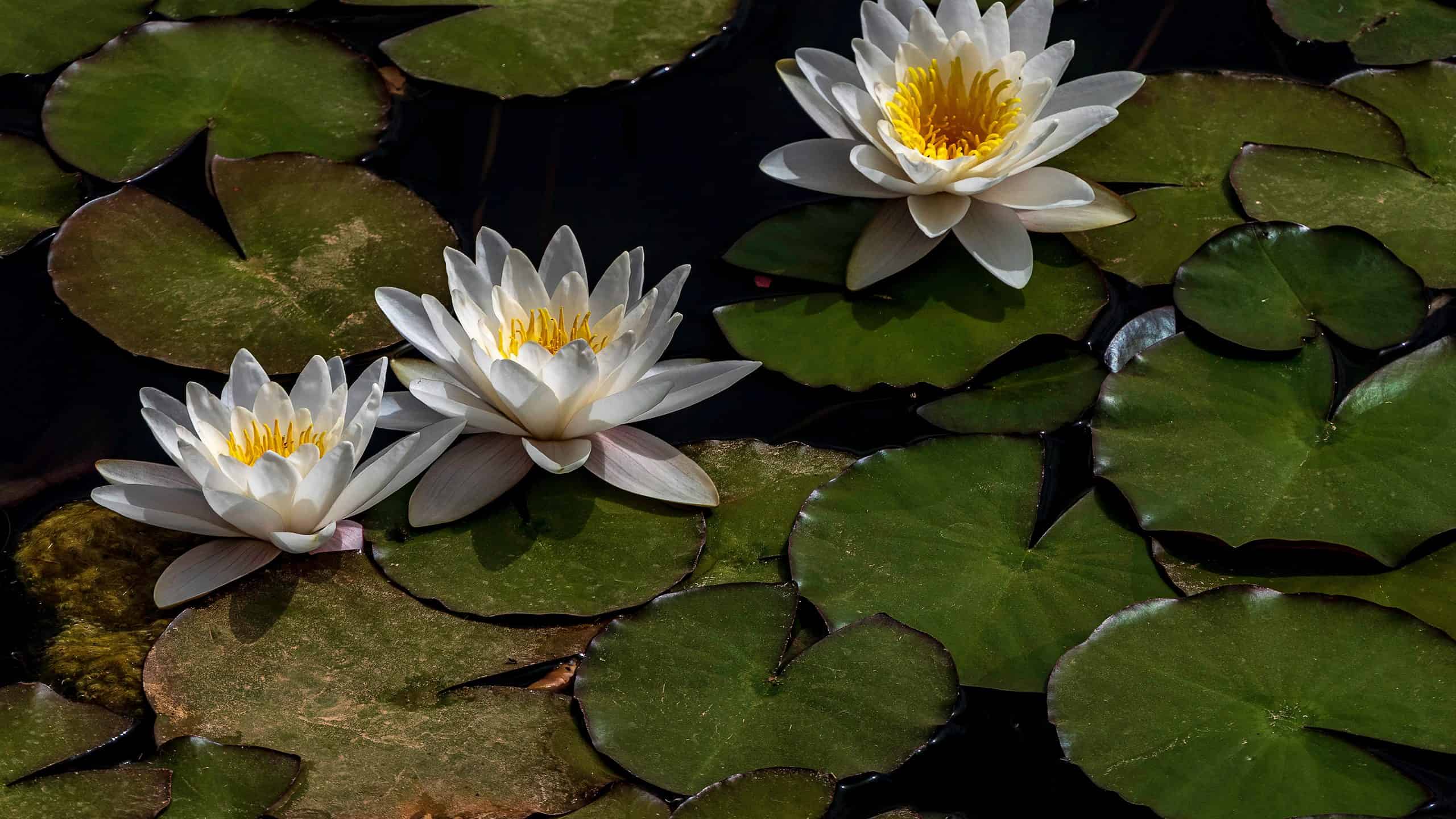Revered for their beauty and deep symbolic nature, water lilies have been a beloved flower for centuries across many different countries. Artists throughout the world have been drawn to their elegance. Claude Monet, the French impressionist, is most famous for painting hundreds of water lilies throughout his career. The water lily is also the national flower of Sri Lanka and the national symbolic flower of Iran. In Bangladesh, it is both the national flower and part of the national emblem. But what is so special about this aquatic plant? Let’s take a closer look at the meaning and symbolism of the water lily!
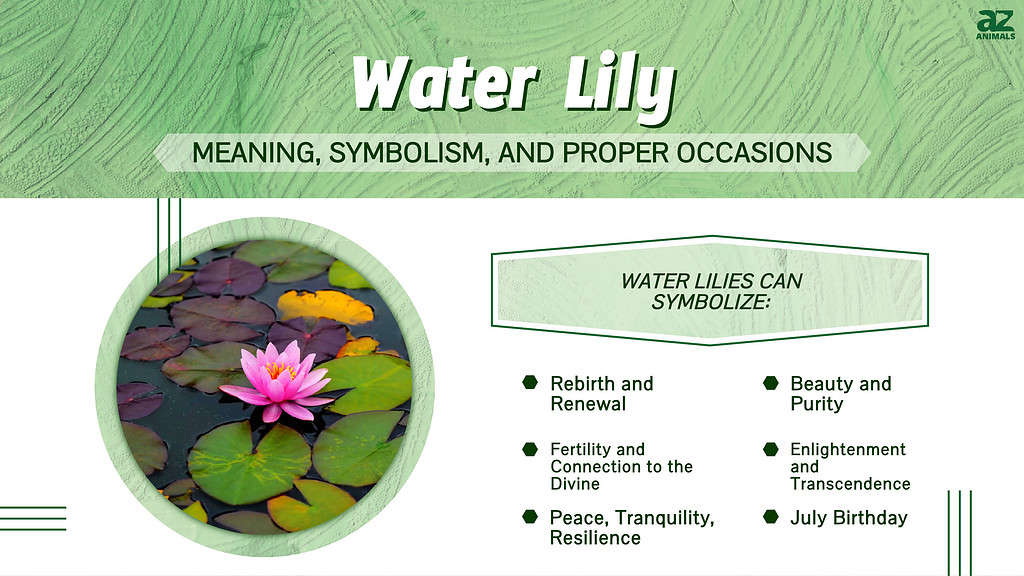
What Is a Water Lily?
Water lilies are aquatic plants that grow along the surface of slow-moving water in tropical and temperate regions worldwide. Found in the Nymphaeaceae family, there are over 60 different species of these unique flowering plants. Growing from underwater rhizomes, water lilies stretch up and out of the mud with large, round leaves and striking flowers that gently float upon the water’s surface.
In addition to their beautiful appearance, water lilies are important to their ecosystems. They help to cover the water’s surface, keeping the water cooler and helping to control algae growth. They also help to filter the water and provide shelter for fish.
Many people use the term “water lily” and “lotus” interchangeably. Although the two are very similar, the water lily and the lotus are actually two different plants. Water lilies belong to the Nymphaeaceae family, while lotus blossoms belong to the Nelumbonaceae family. They can be difficult to tell apart, but in general, the leaves and flowers of water lilies grow on the surface of the water. The leaves and blossoms of lotus flowers, on the other hand, often grow high above the water’s surface on long stocks.
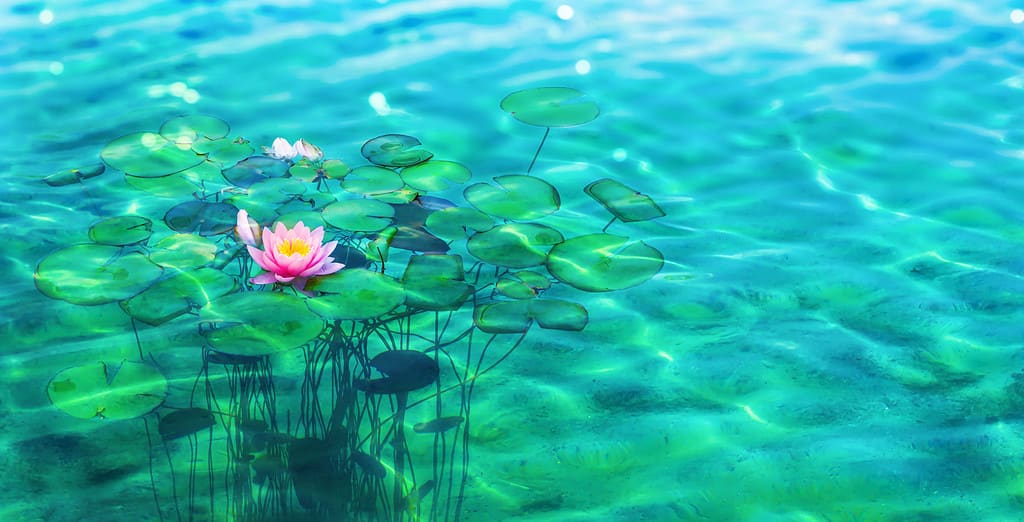
Water lily leaves have special air pockets to help them float on the water’s surface.
©iStock.com/winyuu
Appearance
Water lilies live on the surface of still or slow-moving water in lakes, ponds, and garden pools. They have round and plump leaves that look like little green steppingstones on the water’s surface. Each leaf is coated in a special waxy substance that helps to repel water. However, water lily blossoms are definitely the stars, with some that grow up to 12 inches in diameter! Delicate and beautiful, water lily flowers come in all kinds of different colors, from soft pastels to brighter jewel tones. Many types have a very beautiful fragrance, and some close up their petals at night.
Native Habitat
In the wild, water lilies live in slow-moving streams, swamps, marshes, freshwater lakes, floodplains, ponds, and mangroves in North and South America, Asia, Africa, Europe, and Australia. Hardy water lilies typically live in areas with cold winters. During the winter they don’t flower, but as long as their rhizomes are below the freeze line, they will re-emerge in the spring with new blossoms.
Tropical water lilies, on the other hand, live in warmer tropical climates. Depending on the species, they either bloom only during the day or just at night. Tropical water lilies tend to have larger flowers than hardy water lilies and are often more fragrant.
Growing Tips
Water lilies are typically grown in a garden pool or pond. However, if you don’t have a pond in your yard, don’t worry — you can also plant water lilies in a tub on your porch or patio.
To grow these beautiful aquatic plants, you’ll first need to choose the right variety for your area. Be sure that you select the right variety for the depth of water as well as the climate. In addition, you’ll need to be sure that you plant your water lilies in a sunny location where they can get several hours of sunlight each day.
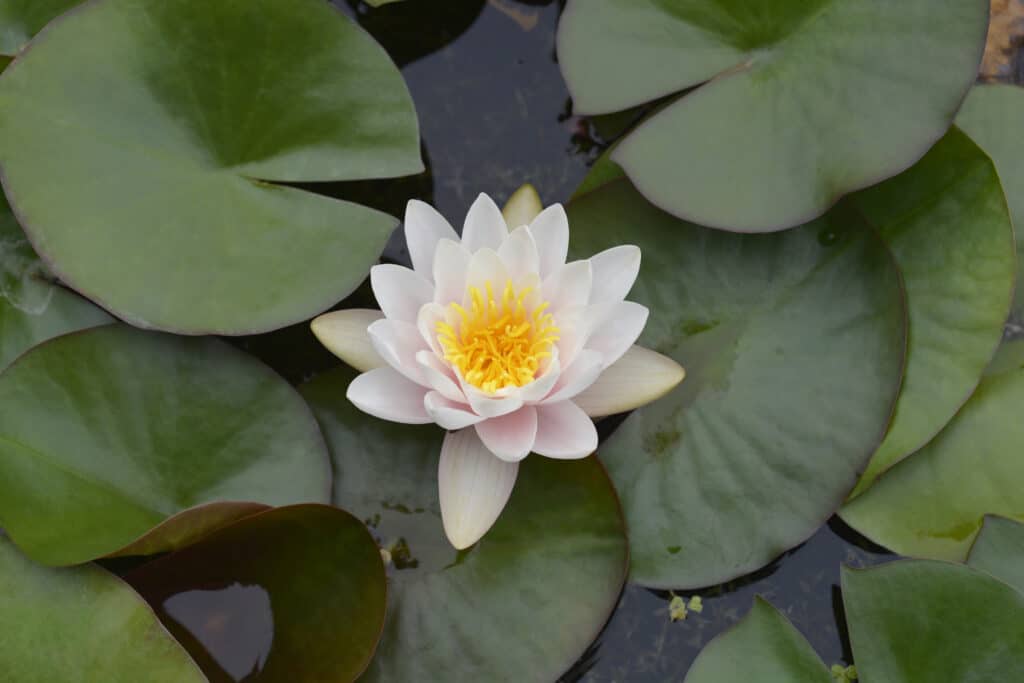
Water lilies are beautiful plants that provide food for fish and wildlife.
©iStock.com/Nahhan
Water Lily Meaning and Symbolism
Rebirth and Renewal
The Egyptian blue water lily (Nymphaea nouchali var. caerulea) naturally grows in the eastern half of Africa and parts of Southern Arabia. The ancient Egyptians often grew these beautiful flowers, regarding them with great religious significance. The flowers of the Egyptian blue water lily rise up out of the water in the morning but then retreat back into the water by noon. The ancient Egyptians saw this as a symbol of the sun emerging from the darkness of night and the constant cycle of life and renewal.
In addition, the white Egyptian water lily (Nymphaea lotus) is the national flower of Egypt and was cultivated by ancient Egyptians in marshes and ponds. Egyptian artists commonly depicted Egyptian blue water lilies and Egyptian white lilies growing in the primordial waters from before the Earth was created. In many legends, these flowers were the first to emerge out of the primordial chaos and are associated with the Sun god, Ra.
The ancient Egyptians also used both types of water lily flowers in decorations, funerals, burial tombs, and temporal offerings. As symbols of rebirth and renewal, they believed that these offerings would nourish both the spirit and body in the afterlife. In fact, many of the powerful ancient Egyptian royals, such as King Tut-ankh-Amun, were covered in blue lily blossoms in their tombs.

Egyptian blue water lilies can still grow well in anoxic mud or low-oxygenated conditions.
©SharonWills/iStock via Getty Images
Beauty and Purity
Water lilies emerge from muddy areas underwater, rising up to bloom above the surface. They symbolize beauty, purity, and innocence, as they can rise above the murky waters without blemish. Water lilies represent the transcendence of the material world and purity in spite of the flower’s darker surroundings.
In addition, water lilies come from the scientific family Nymphaeaceae, which refers to the water nymphs of ancient Greek mythology. Also called naiads, water nymphs were female nature spirits that lived in various freshwater bodies around the world. They helped to protect the body of water where they lived and were well-known for their purity, beauty, and grace.
Fertility and Connection to the Divine
Water lilies were important symbols in the art and iconography of the ancient Maya. As water lilies are aquatic plants that bloom above the water’s surface, they represent a connection between the world above to the world below. Water lilies were seen as sacred flowers and were often seen in relation to the underworld. The ancient Maya also used them in many different ceremonies, rites, altars, stelae, murals, and painted ceramics.
In addition, some scholars believe that the ancient Maya also used water lilies in religious and dynastic rituals as psychotropic substances to help humans connect to the divine. Many Maya artworks include the dotleaf water lily (Nymphaea ampla) alongside Maya kings and jaguars. Referred to as “nikte’ha” or “vulva of the water”, the water lily represented a connection to the divine, life, birth, and fertility.

Some species of water lilies are used in traditional medicine.
©iStock.com/Marina Denisenko
Enlightenment and Transcendence
The water lily is a powerful symbol deeply rooted in the spiritual traditions of Buddhism and Brahmanism in India. With its exquisite beauty and ethereal presence, the water lily seems to float effortlessly along the water’s surface, mirroring the serene state of mind sought by practitioners of Buddhism and Brahmanism.
In addition, the water lily represents enlightenment and the attainment of inner peace in Buddhism. Just as the water lily rises above the murky depths of the pond, the enlightened individual transcends the chaos and suffering of the world to reach a state of ultimate bliss. Similarly, in Brahmanism, the water lily symbolizes purity and divinity. It is often associated with deities such as Saraswati, the goddess of knowledge and arts, and Lakshmi, the goddess of wealth and prosperity. The water lily often symbolizes the ability to overcome challenges and achieve greatness in one’s life.
Peace, Tranquility, Resilience
Water lilies serve as ambassadors of peace and tranquility as their beautiful large blossoms float along the surface of tranquil waters. Even against wind and rain, these beautiful flowers and their leaves remain still and unmoving, symbolizing a profound serenity even in the midst of chaos and trouble.
July
The official birth flowers for those born during the month of July are the larkspur and the enchanting water lily. The water lily is a perfect fit for July birthdays because it blooms from May to September, making July a peak season to enjoy its stunning blossoms.

The water lily has been the national symbolic flower of Iran since the Achaemenid Empire of 552 BCE.
©AlexelA/Shutterstock.com
Meaning and Symbolism of Water Lily Colors
The various colors of water lilies can also add additional meanings that enhance their overall meaning and symbolism. Let’s look at a few examples.
White Water Lilies
The delicate blooms of a white water lily represent the essence of rebirth and renewal, promising a fresh start and revival to weary souls. With their ethereal beauty, these stunning flowers embrace emotions like sympathy and serenity and cast a comforting spell on those in need. In addition, their pure white petals radiate innocence and gentle power amid the dark shadows of the watery depths surrounding them.
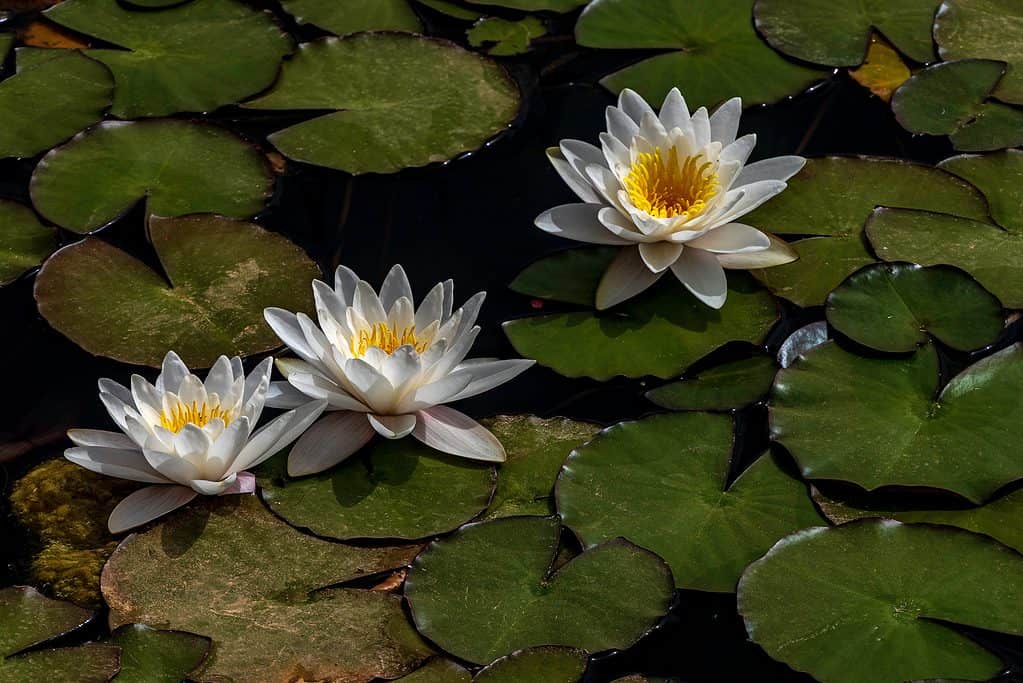
Although it is often referred to as the white Egyptian lotus,
Nymphaea lotusis actually a water lily!
©Emma Grimberg/Shutterstock.com
Red or Pink Water Lilies
Like the fiery glow of a love story, red water lilies symbolize romance and passion. These crimson beauties can also symbolize wealth, abundance, and prosperity, serving as a beautiful reminder that love and riches can sometimes intertwine in the most magical ways.
Water lilies with delicate pink petals, on the other hand, can represent an essence of feminine strength and beauty. In addition, these whimsical blooms also symbolize admiration, friendship, and youth.
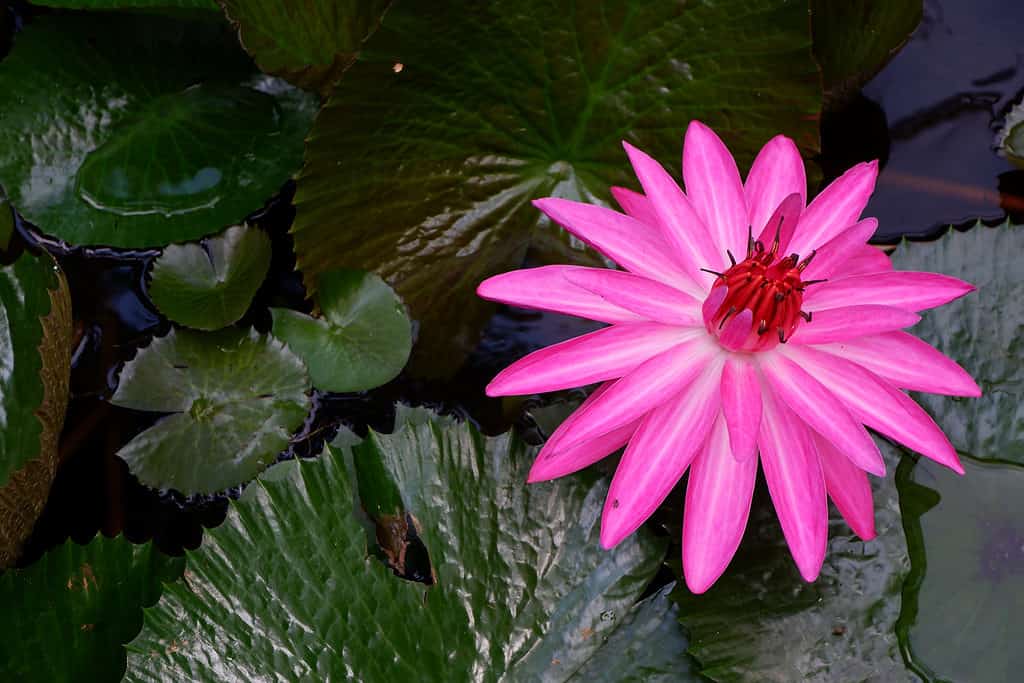
The leaves of the pink water lily or the hairy water lily have “hairy” or fuzzy undersides.
©Sije18/Shutterstock.com
Blue Water Lilies
Blue water lilies symbolize calmness, renewal, wisdom, and tranquility. Blooming along the banks of the Nile Delta in Ancient Egypt, the Egyptian blue water lily also represents the ability to transcend boundaries to create and renew life.

The Director George T. Moore water lily was named after the director of the Missouri Botanical Garden.
©Ivan Yohan/Shutterstock.com
Orange Water Lilies
Water lilies with vibrant orange petals are very spirited flowers that embody confidence and a relentless spirit. Their petals radiate warmth, positivity, and an unwavering sense of assurance. They are sometimes seen as the rebels of the flower garden as they proudly embrace their vibrant individuality. Bursting with energy and a zest for life, orange water lilies remind us of our own unique identity and inner beauty.

In traditional medicine, parts of water lilies are used as anti-inflammatories, sedatives, and astringents.
©Kedar Diwakar Mandakhalikar/iStock via Getty Images
Yellow Water Lilies
The vibrant hues of yellow water lilies symbolize friendship and joy. With their sunny radiance and delicate yellow petals, they exude an aura of boundless energy, renewed vitality, and blessings of good health. Yellow water lilies signify new beginnings and can bring a positive atmosphere to even the gloomiest of days.
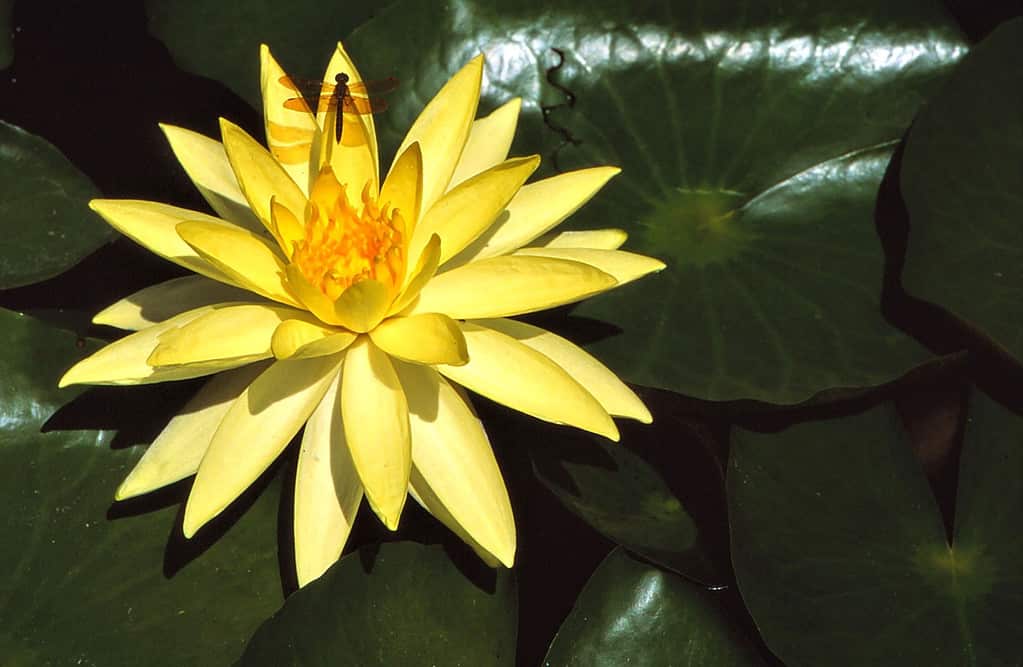
Water lilies are beautiful in garden ponds, but some varieties grow quite profusely and take over.
©Richard Jackson/iStock via Getty Images
Purple Water Lilies
Whether rich jewel tones or gentle pastels, purple water lilies represent an essence of grace, regality, wonder, and triumph. These majestic flowers exude elegance and enchantment, transporting you to a realm rule by grandeur and grace.
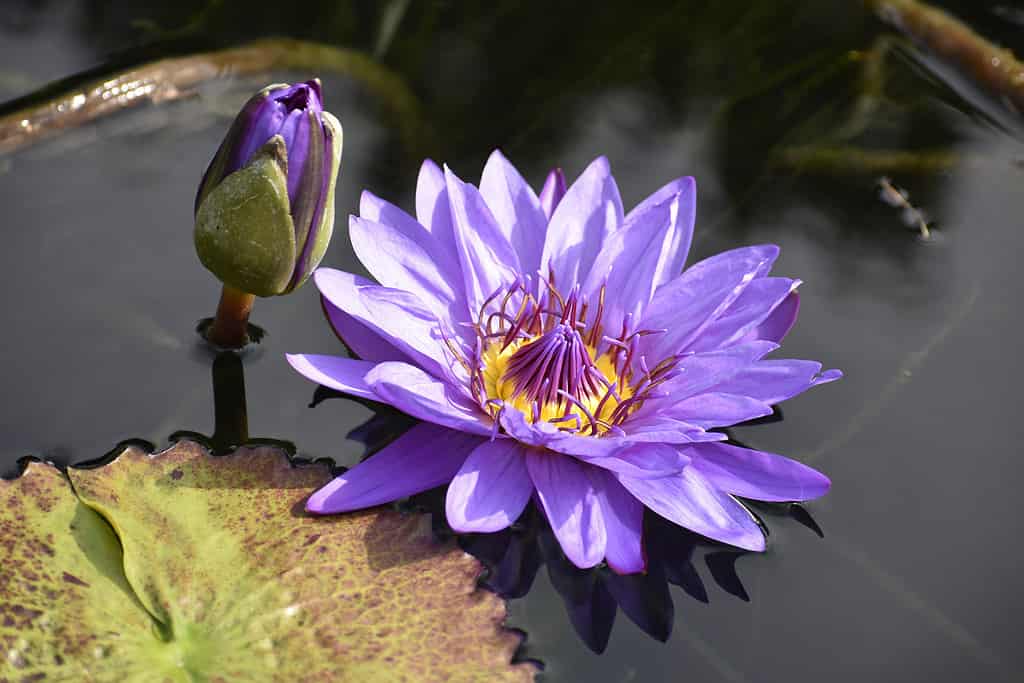
Water lily blossoms typically only last for three or four days.
©gurineb/iStock via Getty Images
Proper Occasions for Water Lilies
Funerals and Remembrance
Water lilies are not only beautiful and elegant, but they are also revered as a symbol of the connection between life and death. They can create a serene and peaceful floral arrangement to honor those who have passed on, offering solace and reflection, as well as a gentle reminder that even in the darkest moments of our lives there is beauty and transformation.
July Birthdays
Water lilies are the epitome of summer’s beauty, reminding us to embrace all the joy and wonder that life has to offer. Blooming from May through September, water lilies radiate warmth, positivity, and the renewed promise of another wonderful year. Whether gifted in a bouquet, as a plant for a garden pond, or as a delicate necklace pendant, water lilies bring a touch of nature’s beautiful artistry into the lives of anyone lucky enough to be born in July.
Gifts for Art Lovers
If you need a gift for an art lover who appreciates Impressionism, then why not go for the delicate beauty of a water lily? Water lilies evoke the spirit of the famous French impressionist, Claude Monet. Capturing the spirit of Monet’s artistry, these flowers immerse us in the colorful landscapes and tranquil waters of the artist’s most famous paintings.
In his Water Lilies (Nymphéas) series, Monet produced around 250 enormous oil paintings featuring water lilies. A water lily can transport the receiver to the tranquil waters of Giverny, where Monet himself once stood as he tried to capture the infinite changes in light and color reflected on the water’s surface.
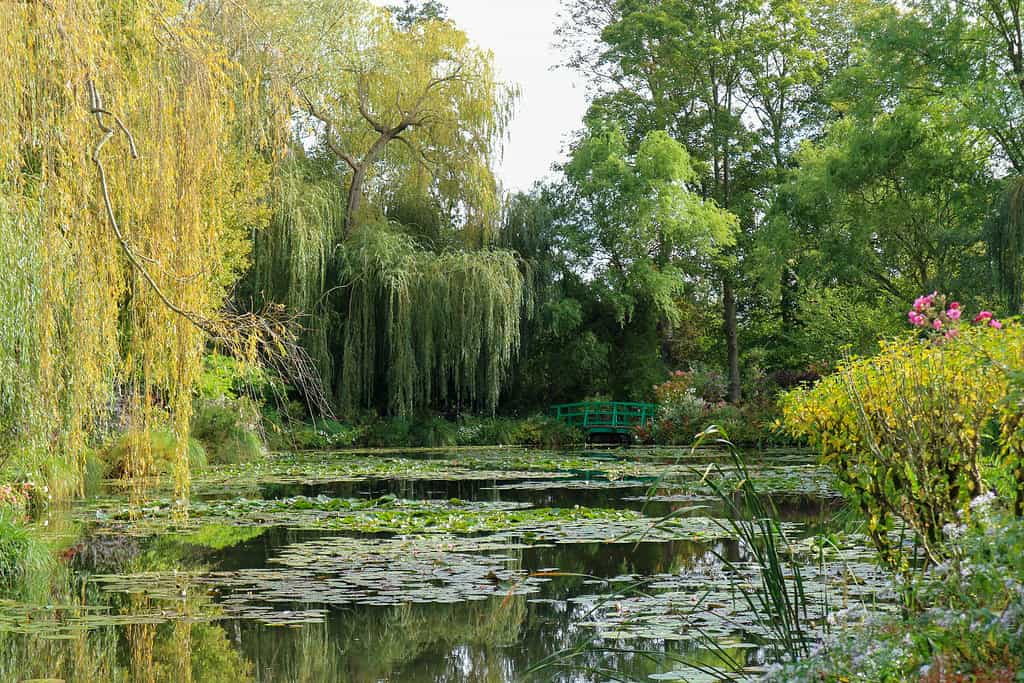
Monet spent the last 30 years of his life painting the water lily ponds at Giverny in Northern France.
©Luisa Carazzi/iStock via Getty Images
Weddings and Anniversaries
Symbolizing new beginnings and transformation, water lilies are a perfect choice for wedding decorations and bridal bouquets. In addition, their serene presence and beautiful appearance create an atmosphere of tranquility and bliss, casting a magical spell upon any celebration of love. Many types of water lilies also have a lovely fragrance, which can add to an already beautiful event.
Water lilies are fabulous for anniversaries as well as weddings, as they represent transcendence and resilience, reminding couples that they can make something beautiful even amid the difficulties and challenges of life.
Religious Ceremonies, Baptisms, and Christenings
Symbolizing a bridge between mortality and the divine, water lilies are often used to adorn alters and temples with their ethereal presence. Their serene beauty and grace invite us to pause and connect with something bigger than ourselves.
In addition, water lilies serve as beautiful symbols of new life and rebirth, making them the perfect addition to events like baptisms and christenings. Their ethereal blooms represent spiritual transformation, inviting us to immerse ourselves in the waters of renewal. Water lilies symbolize being born again and celebrate the dawning of a new chapter.
Meditation and Yoga Practices
The gentle presence of an elegant water lily can produce tranquility in meditation and yoga practices. Water lilies seem to embody a feeling of peace and Zen, creating an atmosphere of calmness and serenity. A tub of water lilies or a bowl with a water lily is an especially poignant symbol, reflecting the essence of a peaceful mind and the importance of stillness. In addition, water lilies represent a balance between worlds and remind us to find solace amidst the ebb and flow of life’s changes.
Thank you for reading! Have some feedback for us? Contact the AZ Animals editorial team.

